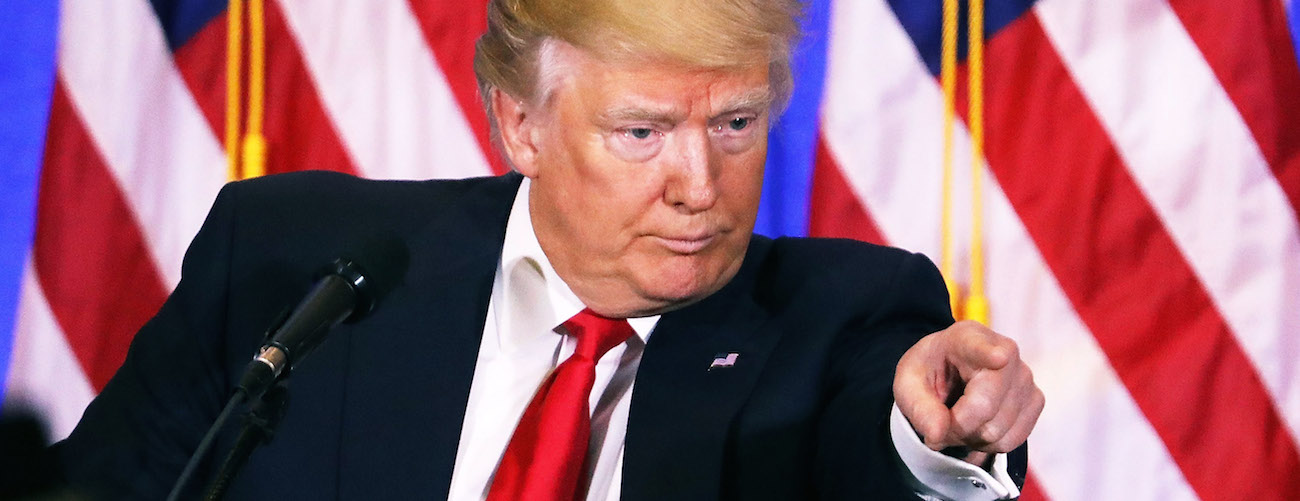The most confrontational moment of Donald Trump’s first press conference in 168 days featured the President-elect pointing his finger at a CNN reporter and declaring, “You are fake news.”
CNN Senior White House Correspondent Jim Acosta stood pleading with Trump to acknowledge his question, referencing earlier attacks made by Trump and his press secretary about the accuracy of a CNN report detailing Trump’s ties to Russia. “Mr. President-elect, since you have been attacking our news organization, can you give us a chance?” Acosta yelled above the scrum of reporters.
“No! Not you. No! Your organization is terrible,” the President-elect shot back. When Acosta persisted in shouting for recognition, Trump pointed a finger at him and said, “Don’t be rude. No, I’m not going to give you a question.”
Donald Trump refuses to take a question from CNN’s Senior White House Correspondent @Acosta https://t.co/SYIPLekALG https://t.co/Im5Dlc38B4
— CNN (@CNN) January 11, 2017
Trump then turned to the next question, and the press conference proceeded from there. It was a striking moment not only for the direct confrontation between the two men, but also for the fact that it seemed to have no effect on other journalists in the room. No one immediately leapt to Acosta’s defense.
Related: Eight steps reporters should take before Trump assumes office
In the hothouse of a packed Trump Tower lobby, with dozens of reporters trying to get their questions in, it’s understandable that no one stopped to consider the implication of Trump’s actions. But watching on television, I wished those journalists in attendance had picked up Acosta’s line of questioning, or even refused to continue asking questions, until the President-elect acknowledged the organization he had earlier attacked.
Journalism is a competitive business, but it’s not a zero-sum game.
Journalism is a competitive business, but it’s not a zero-sum game. We all campaign for scoops, access, and sources, but we are, effectively, on the same side. If Trump ignores or blacklists outlets he deems hostile, and others in the industry don’t defend them, the public loses out on the perspective those reporters bring, and we as an industry lose out in our efforts to hold power accountable.
Confronting Trump directly runs the risk of playing into his complaints of a biased press. But Trump is no longer a candidate. After the election, CJR Editor Kyle Pope called for a return to the journalist as malcontent. Today’s press conference presented just such an opportunity.
Acosta later said on CNN, “Sean Spicer, the incoming press secretary, did say to me that if I were to do that again, I was going to be thrown out of this press conference.” It would not be the first time that team Trump had ejected a reporter to whose work the President-elect objects. In August of 2015, Univision anchor Jorge Ramos was ejected from an Iowa press conference after challenging Trump on his comments about Mexicans as rapists.
Ramos was soon allowed back into the room due, at least in part, to the lobbying of Tom Llamas from ABC and Kasie Hunt from MSNBC. This fall, Ramos told CJR that he appreciated their support, but also noted that no other journalists in the room came to his defense.
Related: BuzzFeed was right to publish Trump-Russia files
Today, the question Acosta wanted to ask–whether Trump or anyone on his team had been in contact with Russian authorities–was eventually posed by ABC News’ Cecilia Vega. Trump did not directly answer the question during the press conference, but Vega reported that, as he was walking from the podium, he told reporters neither he nor his team had interacted with Russian agents. It was unclear, based on Acosta’s later comments, whether that was coincidental, or whether Vega was taking up his line of questioning on purpose.
Much has been made of Trump’s relationship with the press, and fears about his views on the First Amendment as well as traditional norms are justified by his actions. With just over a week until he assumes power, the press needs to be ready to work together to ensure that reporters are provided the access and information necessary to accurately and honestly cover the new administration.
Standing in the way of such a united effort to push back against Trump’s singling out certain organizations is the fractured media industry itself. In the past, there may have been some utility to reporters working as a group, but with unabashed boosters in the studios of certain Fox News hosts, the morning hours of MSNBC, and the pages of Breitbart, as direct access to 17 million followers through his own Twitter feed, Trump has a greater ability than any previous president to push his message unchallenged.
Next Friday, the new administration begins. As a candidate, and now as the President-elect, Trump and his team have shown a willingness to retaliate, bully, and ban journalists whose questions he doesn’t want to answer. As an industry, we must be prepared for more moments like today’s, and we must be ready to respond accordingly.
Related: Journalism’s moment of reckoning has arrived.
Pete Vernon is a former CJR staff writer. Follow him on Twitter @ByPeteVernon.

